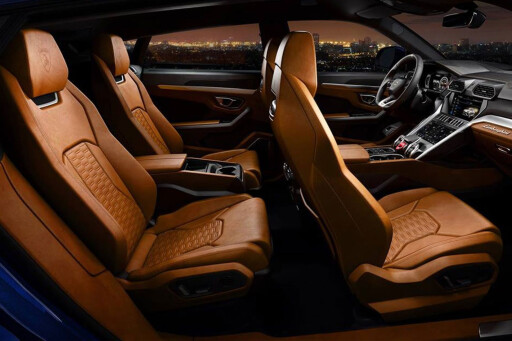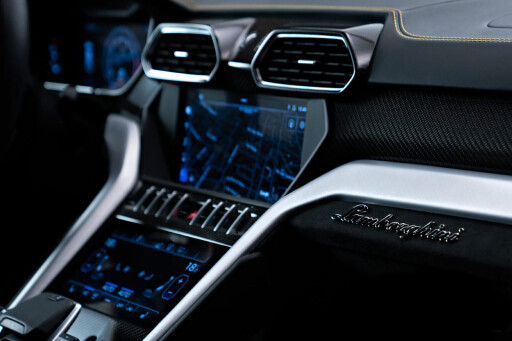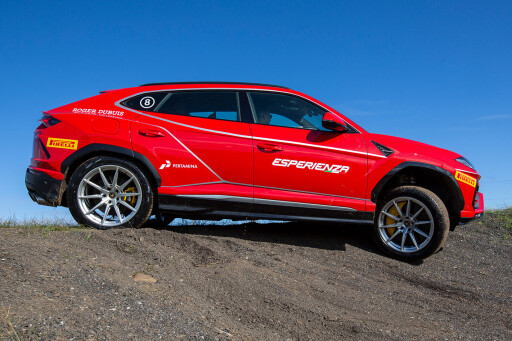
Overall Rating

Plus & Minus
Plus Eye-popping agility; sense of occasion; everyday utility
Minus Hardly the acme of discretion; appetite for consumables; value can be questioned
The Wheels Verdict: How good is a Lamborghini Urus? Strangely, it’s almost an irrelevance. An overwhelming proportion of Urus buyers want one because it’s a Lamborghini that the family can travel in and need no further justification. That it’s also a car that does enough to merit the raging bull on its bonnet will satisfy those well acquainted with Lamborghini’s tumultuous timeline. While sales of Urus continue to swell, lifting the company towards 7000 cars per year, we doff our caps to this super-SUV. It’s the car that’s going to fund the next generation of Sant’Agata’s hyper sports cars. Whatever else it does, it earns our respect for that.
WHAT IS THE LAMBORGHINI URUS?
Lamborghini isn’t just a company that makes mid-engined supercars. In the past it built elegant 2+2s, four-seater grand tourers and the imposing LM002 four-wheel-drive truck. It’s this latter vehicle which paves the way for a new generation of Lamborghini utility vehicles, spearheaded by the Urus. An SUV from the very top tier, it now accounts for fully 50 percent of all production out of Sant’Agata and brings to market a very special set of skills.
WHY WE'RE TESTING IT
The opportunity to put the Urus through its paces both on track and off-road wasn’t something we were about to forgo. The question we really wanted to answer was whether this slice of exotica could justify the premium over something like a Porsche Cayenne Turbo.
LAMBORGHINI URUS REVIEW
“Where do I end up if I outbrake myself at the end of the straight,” I ask Lamborghini’s lead instructor at Phillip Island. “Nowhere good,” comes the blunt reply. I probably shouldn’t worry too much about that. The Lamborghini Urus I’m driving is equipped with braking hardware that could probably stand an Airbus A380 on its nose. The 440mm carbon ceramics up front are the biggest brake discs fitted to a production car and are clamped by 10-pot calipers. The rear rotors are only 10mm smaller than the front discs on a 911 GT3.

But then you need a decent set of stoppers when you combine 478kW with 2200kg. What you don’t expect is how effortlessly the Urus seems to shuck off that heft. Put most big SUVs on a racetrack and they’re about as elegantly composed as a frog in a sock. The Urus feels as if it could lap Phillip Island all day. It can’t, of course, because it would require a frankly terrifying fuel, tyre and brake budget to keep the thing lapping at pace, but as a demonstration of capability, it’s hard not to be impressed.
Of course, there will always be those who refuse to be impressed, who feel that the Urus is a blot of Lamborghini’s copybook. They’ll disparage it as an Audi Q7 in a party frock, an entirely cynical means to an end. Here’s a fact though. There are Urus haters and there are those who’ve driven the thing. True, most things would be improved with the addition of a naturally aspirated V12, but in the world of commercial realities, the Urus is as good as you could possibly hope for.
.jpg)
Jump inside and it’s tempting to start spotting the Audi bits, but it’s a fairly jaded exercise. You could engage in the same churlish nitpicking on a 16-year-old Gallardo. You should be used to some things by now. I’m not sure that some of the plastics are what you’d expect if you’re forking over $390,000 and the whole edifice that houses the ‘Tamburo’ mode selector, gear lever and start button is no great triumph of ergonomic elegance or materials quality.
The infotainment system is effectively a re-skin of Audi’s MMI Navigation Plus architecture and it’s very good, comprising two high-res haptic touchscreens. The top one marshals most of the controls while the lower one is relegated for HVAC controls and hot-key short cuts. There’s a flat-bottomed steering wheel (of course) and a glitzy digital dial pack. The stitched leather trim is excellent, and accommodation in the vehicle, whether configured with a rear bench for three or a pair of reclining seats, was par for the course. The boot’s a decent size (616L) but there’s no spare beneath the floor.

Flip the red-hinged cage and hold the starter button and the Urus growls to life without the theatrical flare of revs of the supersports cars. Your first impression is of almost freakish manoeuvrability. The leviathan Urus’s turning circle is just 11.8m, or about the same as a Mazda CX-5, thanks to its all-wheel steer system. The steering feels hyperalert at low speeds, but we’re not really here for low speeds.
Mash the throttle and 100km/h arrives in 3.6 seconds without any histrionics from the drivetrain. Get really ambitious with the final corner at Phillip Island’s GP Circuit and you might even nudge the top speed of 305km/h at the end of the straight before your Bass Strait proximity sensors start pinging. Switch it into Corsa mode and you get a fusillade of crackles and bangs on the overrun and some bass from the exhaust which make up for the 4.0-litre V8’s slightly turbo-generic vocabulary.

All 850Nm are available at any point between 2250 and 4500rpm, so manually clacking up and down the eight-speed ZF auto feels fairly superfluous. Leave the software to figure the gears out and you can concentrate on the scenery exploding through the windscreen at a dizzying rate. Pile on some speed and the Urus is quicker than a BMW M5. It corners, too.
Lamborghini has purloined the best available tech from every outpost of the Volkswagen Group for the Urus. Active anti-roll bars virtually cancel bodyroll through corners and smart drive logic is assisted by the fitment of a Torsen self-locking centre differential and a torque-vectoring rear differential. The air suspension adjusts ride height where required, offering up to 248mm of ground clearance, and does a decent job of mopping up surface imperfections.
To get the best from the Urus, you need to almost bully it through corners. At ‘normal’ speeds, it feels as if the electronics have all the answers. Push harder to the point where you begin to feel the weight transfers and it still feels all of a piece, even in Corsa. The chassis’ sleight of hand only goes so far, however, and the Urus never quite convinces as a tactile thing. The steering doesn’t deliver faithful feel, the carbon ceramic brakes respond well to a good stamp but can be tricky to feather, and the tyres can overheat without too much provocation.
 We even got to try the vehicle off-road on a course that was largely tailored to its specific clearances. Plus Lamborghini had fitted the Urus for the off-road course with the highest-profile tyres available and those for the track with the most focused rubber, which demonstrated the bandwidth of the Urus, if a skewed measure of both capabilities.
We even got to try the vehicle off-road on a course that was largely tailored to its specific clearances. Plus Lamborghini had fitted the Urus for the off-road course with the highest-profile tyres available and those for the track with the most focused rubber, which demonstrated the bandwidth of the Urus, if a skewed measure of both capabilities.
With the drive mode switched to Terra, or off-road, the Urus can clamber reasonably well, although so much comes down to your choice of tyre. There’s no low-range transfer case, but the Urus does get an effective hill descent control that works in both drive and reverse gears. Towing? You’ll be able to drag a 3.5-tonne braked trailer or a 750kg unbraked unit. An 85-litre fuel tank should give decent range when you’re not at full tilt on a GP circuit, although the quoted fuel consumption figure of 1.2.6L/100km is optimistic
Objectively, the Urus is hard to make a case for. You could save yourself $150,000, opt for a Porsche Cayenne Turbo and own a car that’s almost as capable. In this corner of the market, however, ‘almost’ isn’t good enough. If you’re dealing with absolutes, the Lamborghini Urus aces every other super-SUV. Its extremity is its salvation and, indeed, that of Lamborghini as a company. It’s a keystone product for the brand and it stands up as a worthy wearer of the raging bull badge.

MAIN RIVALS
Bentley Bentayga; Porsche Cayenne Turbo, Tesla Model X Performance
PRICE AND SPECS
Model: Lamborghini Urus
Engine: 3996cc V8, dohc, 32v
Max power: 478kW @ 6000rpm
Max torque: 850Nm @ 2250-4500rpm
Weight: 2280kg
Economy: 12.6L/100km (claimed)
0-100km/h: 3.6sec (claimed)
Price: $390,000
On sale: Now



COMMENTS